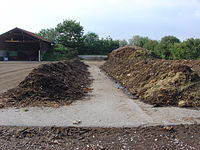
Photo from wikipedia
Abstract Nowadays, the extensive use of inorganic fertilizers has increased the salinity of soil and decreased optimal assimilation of nutrients by crops. Organic carbon is basic for controlling the nutrient… Click to show full abstract
Abstract Nowadays, the extensive use of inorganic fertilizers has increased the salinity of soil and decreased optimal assimilation of nutrients by crops. Organic carbon is basic for controlling the nutrient level in soil and nutrient assimilation by plants. The objective of this study was to develop a process for recovering organic carbon using compost from mixed municipal waste as raw material. The use of fertilizers from organic residues could replace mineral fertilizers, contributing to resources preservation and recycling of organic matter. In this way, a Taguchi experimental design was proposed to select the most suitable operating conditions for recovering organic carbon from the organic residue. The variable factors were the solid:liquid ratio, type of solvent, extraction time, and particle size. The optimum extraction conditions were: solid:liquid ratio 1:2.5, 1 M potassium hydroxide (KOH), 72 h, and particle size > 1 mm. Subsequent experiments concluded that separating the mixed municipal waste compost (MMWC) by fractions of different particle sizes before extraction process is not recommended. Under these conditions, the total organic carbon concentration in the extract was 6.9% w/w, of which the content of humic acids was 47.6%. On the other hand, the extract complies with the legal requirements of Regulation (EU) 2019/1009 for fertilizing products regarding composition. Germination tests were carried out to analyze the phytotoxic effects of organic extracts. Finally, a preliminary economic study showed the viability for a production plant with a capacity of 300 kg/h of MMWC. The production of liquid fertilizer was 200 L per 100 kg of dry compost, and the estimated sale price to obtain economic benefits was 1 €/L of fertilizer for a plant whose total investment cost was 1,600 k€.
Journal Title: Journal of Cleaner Production
Year Published: 2020
Link to full text (if available)
Share on Social Media: Sign Up to like & get
recommendations!